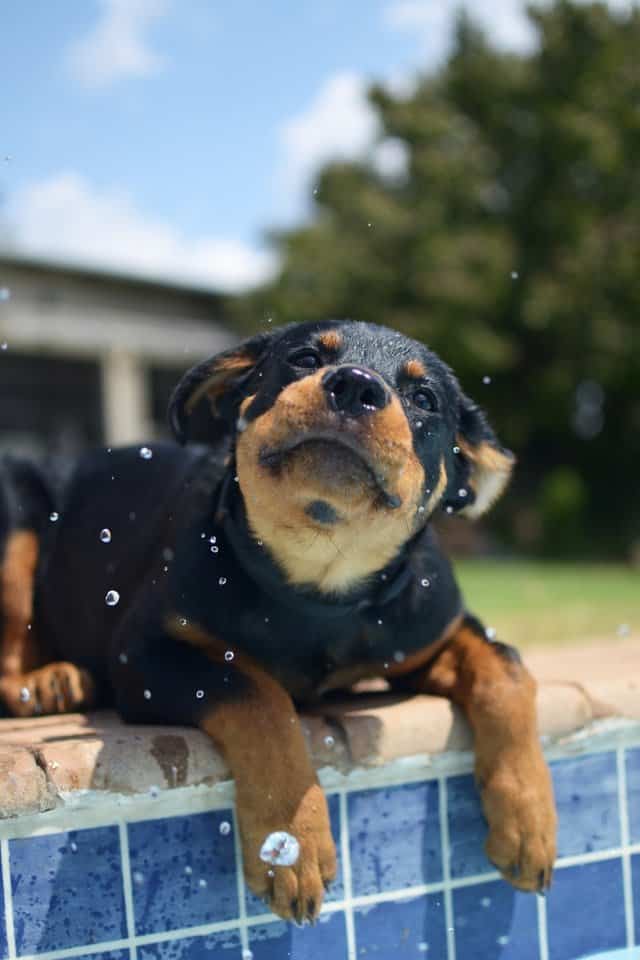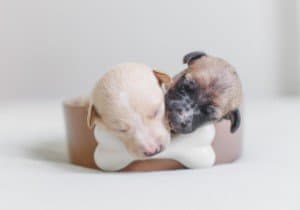
Whether you’ve just gotten a new puppy and you’re trying to figure out a way to stop them from peeing all over the house while you’re sleeping, or you’ve had your dog for a while and you simply want to know more about proper hydration etiquette, making sure that your dog is healthy should always be your top priority as a pet owner.
It can be frustrating having to deal with a fresh delivery of urine each morning as your pup grows up, but maybe you’re unsure about whether or not it’s safe to keep them from drinking water for the duration of the night. Well, here we will talk about the need-to-know elements of proper doggy hydration.
How long can a puppy go without water?
There is a basic rule of thumb that adult dogs can survive around 3-4 days without water but one of the things that we know for sure is that puppies and need more water than adult dogs.
And puppies need more water because they are still growing- and perhaps because puppies tend to charge around all over the place.
And older dogs need more water than “middle age” dogs.
Of course, exactly how much water any dog really needs depends upon 4 factors:
- age- see above
- size- bigger dogs need more water
- temperature- in hotter conditions, dogs need more water
- diet- a dog that eats dry food needs more water than a dog on a wet food based diet
- level of activity- the more active a dog is, the more water they need.
Because the amount of water that a dogs need depends on their size, the amount of water that a puppy needs will alter as they grow.
And the basic calculation is that for every pound of body weight, your puppy needs between 0.5- 1.0 oz of water.

water.²
Although your dog will be able to survive for roughly half a week without any water, dehydration will start to take its toll on your canine friend a lot sooner than that.
This can be nasty for your dog’s health and lead to an increased heart rate or a weaker pulse than normal, a lack of energy, shivering, discoloured gums, fainting, and even death.
Unless there’s a specific reason to keep your dogs from consuming excess amounts of water, it’s good to have clean water readily available for them at all times.
This is particularly important on hot days where dehydration becomes a more prominent force to deal with. The general rule is that your dog will consume approximately twice as much water than the food they’re eating in an average day. So if your pooch is eating around 3 cups of food per day, they should go through roughly 6 cups of water.
Before you’ve gotten around to effectively training your pup not to pee in the house, figuring out a routine so they don’t wreck your floor during the night can be challenging. You might decide to take their water bowl away during the night to help reduce their need to relieve themselves and there’s nothing wrong with that.
A dog can go without water for 8 hours without any hassles but a pup will likely want a drink of water and a pee break within the first 4 hours of bed time. If you’re worried, you can always add a bit of moisture to their meal so they can stay a bit more hydrated.

their meal! ³
Until they get a little older and develop better bladder control, there is very little you can do about the midnight mess. Putting down newspaper in the areas they typically like to urinate can make it easier to clean up in the morning.
Potty training should be a priority at this stage. The sooner you can get your pup to realize that they need to go outside for a pee, the sooner you can do away with stepping in puddles when you wake up and your house can go back to smelling normal again.
If you’re busy at work for the majority of the day, you might want to get a pet sitter to attend to your dog’s food and drink requirements while you’re away. If you’re on the road, remember that if you’re thirsty or you feel like you need to use the toilet then it’s most likely the same case for your dog.
How to tell if your dog is suffering from dehydration?
A lack of hydration can result in the loss of proper organ functionality. This can make it difficult for the body to dispose of waste, deliver nutrients efficiently throughout the body, maintain properly lubricated joints, and digest food adequately. High temperatures can make it difficult to keep sufficiently hydrated but on top of that, some dogs have a natural disposition to overheat which makes it even more of a challenge to keep them cool and hydrated.
- Tips on How to Train Puppy to Potty: Advice from Puppy Potty Training Experts
Just as it is with humans, a dog’s urine will be yellow if they are dehydrated. Darker shades of yellow indicate more severe levels of dehydration. There are other signs to pay attention to as well such as a lot of panting, a dry nose, dry gums, excessive sleepiness, dry eyes, and a poor appetite. You can also softly lift up your dog’s skin and if it takes longer than usual to reform back into its regular position, then there’s a good chance he or she is dehydrated. This of course requires you to be aware of what your dog’s skin elasticity is like in general for comparison. A good trick to make sure your dog has access to clean water constantly is to install a water dispenser rather using a regular water bowl. This will allow you to have more water ready to drop down into the bowl as your dog drinks.
Helpful bedtime practices for your dog
Although it’s pretty much inevitable that your puppy will pee somewhere in the house in the beginning stages of growing up, there are a few techniques you can try to make the process a little easier. Much like your own habits that you engage in before bed, you should learn to form a routine for your pup as well.
A helpful tool is to ensure that your dog is getting enough exercise during the day. Playing fetch or going for walks together is a great way to drain your dog’s surplus energy, so when it comes to bed time, it should be easier for them sleep better and for a longer period of time. A late afternoon walk before a good meal should tire out your dog nicely.
It might sound strange, but some dogs respond well to calming music to reduce their anxious energy. It can be difficult while your pup is getting accustomed to the noises around the house. Every little noise could wake them up and stress them out, and you’ll probably be the one to have to get up and get your pup to relax again. Classical music might help to overpower the triggering noises in the area, but the downside to this is that it’s going to take longer for your dog to adapt to their surroundings if they suddenly have to sleep without their favourite tunes.
Another approach is to let your pup sleep with something they love. It could be their favourite toy, a particular blanket, or one of your shirts that will remind them of your presence. This might help to soothe your puppy’s overactive mind and make him or her feel safe. You might also want to consider putting your dog’s bed next to yours so that they feel protected. This will make it easier for your pup to remain calm and for you to manage any potential problems they might have in the middle of the night. This doesn’t need to be a permanent setup, but it can help at the start while your puppy gets used to the house.
Seeing as you live with each other, you and your dog are bound to affect each other in a number of ways. As your bond develops, certain habits will start to apply to the both of you. Either you’ll need to learn to get up early in the morning to let your pup outside so they can do their business, or if you’re a night owl, your dog will learn to go to sleep later and as a result they’ll wake up later in the day. Many people are forced to get up at 5am because their dog can’t wait to start the day!
What to look out for if your dog is drinking too much water
How much water a dog consumes will vary depending on the size and breed of the dog, how much physical activity they do in a day, and how hot it is in your area. A healthy/normal amount of water intake in a day is typically around 20 to 70ml per kilogram of bodyweight. If your dog is drinking more water than they should (a condition referred to as polydipsia), it could be a sign of an underlying problem such as kidney failure or diabetes. If they’re not drinking enough water then there may also be a fundamental issue that requires attention and in either case, you should take your pooch to see a veterinarian to have them checked out. Once your vet has done urine and blood tests, you should have a clearer idea of what the problem is. Sometimes dogs will drink too much water out of boredom, even to the point where they throw up, so it’s important to have a professional assess the issue.
Closing thoughts
If your dog is battling with a health problem, restricting the amount of water they drink could worsen their condition, so rather try other methods if you’re hoping to stop them from urinating at night. If you think your dog isn’t getting enough water, adding moisture to their food can be an effective way to get more fluids into their system. If you can, keep multiple sources of water around the house. One bowl in the lounge or kitchen and one outside in the garden should be a standard. Consult a veterinarian if you’re unsure about whether or not you’re doing things correctly.
Photo Credits
¹ Photo by Stephanie Cook on Unsplash
² Photo by Berkay Gumustekin on Unsplash
³ Photo by sergio souza on Unsplash





